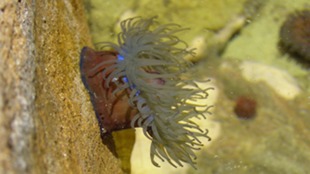 Elephants run from bee soundsLUCY KING, OXFORD UNIVERSITY
Elephants run from bee soundsLUCY KING, OXFORD UNIVERSITY
Bee gatekeepers

Elephants may not actually be afraid of mice, but they are terrified of bees. Now, a team of researchers has taken advantage of this phobia to protect the crops of Kenyan farmers. In a test run published in the current issue of The African Journal of Ecology, scientists installed 1,700 meters of fences along the boundaries of 17 farms in Northern Kenya with a beehive situated every 10 meters and compared that to 1,700 meters of neighboring farm boundaries protected only by thorn tree fences. Over two years, the beehive fence far surpassed the thorn fence in elephant deterrence: only one elephant broke through the beehive fence, while 31 elephants crashed through the thorn fence. (Hat tip to ScienceNOW.)
Handyfish

A professional diver has captured the first ever photographs...
There have been a handful of reports of fish using rocks or coral as anvils to crack open hard-shelled prey, but there's been no photo or video evidence to back it up, Culum Brown, co-author of the paper at Macquarie University in Sydney, Australia, told ScienceNOW.
Spunky anemones

They sometimes appear to be lifeless, underwater blobs, but sea anemones (Actinia equina) may actually have personalities, researchers from the University of Plymouth in the UK announce this month in PLoS ONE. Animal personality has been defined as differing behavior among individuals in a way that is consistent over time. (See The Scientist’s 2010 feature on the topic.) The authors of the paper found that after being surprised with a squirt of water, individual sea anemones kept their tentacles withdrawn for unique but consistent amounts of time that varied from individual to individual. The trend held regardless of the temperature in the anemones' tide pool homes, a variable that can affect behavior, ScienceNOW reports.
Caught on camera
A camera “trap” has caught 30 rare snow leopards on tape in 16 different locations in the wilds of Afghanistan—many more leopards than researchers expected based on the frequency of poaching and retaliatory killing by shepherds in the region. “This is a wonderful discovery—it shows that there is real hope for snow leopards in Afghanistan,” Peter Zahler, deputy director for Asia Programs of the Wildlife Conservation Society, which sponsored the research, said in a press release. The findings were published June 30 in the International Journal of Environmental Studies.

Picky arachnids

Male pseudoscorpions (Cordylochernes scorpioides) tiny arachnids that live beneath the colorful wings of the harlequin beetle, make a bigger investment in virgin females than females who have already mated with other males. Published last week in Ethology, researchers found that male pseudoscorpions deposit nearly three times more sperm in virgin females than in females exposed to three previous mates, which the males can distinguish between based on chemical cues. The strategy prevents males from “wasting ejaculates on deceitful, mated females,” the authors write, as mated females often feign sexual receptivity, mate, and then reject sperm packets produced by undesirable males.
Male black widow spiders (Latrodectus hesperus) are also picky about their mates. Males court well-fed females significantly more than starved females, according to new research published in the August issue of Animal Behaviour. Even in the absence of the female spiders, males began a courtship ritual on the webs of well-fed spiders more often than starving ones, based on chemical cues. The bias may have evolved because starved females are more likely to skip sex all together and eat the courting males, the authors suggest.



